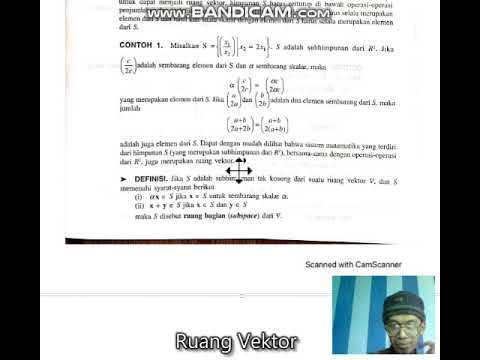4 1 Real Vector Spaces
Summary
TLDRIn this algebra lecture, Junita explains the concept of vector spaces, focusing on their properties and axioms. She covers the basic operations of vector addition and scalar multiplication, highlighting the 10 axioms that a set must satisfy to be considered a vector space. Junita provides various examples, including the zero vector, real-number spaces (R^n), and 2x2 matrices, showing how they meet the criteria. She also discusses cases where sets fail to be vector spaces, such as when they don’t satisfy closure under scalar multiplication. The video serves as a comprehensive guide for understanding vector spaces in algebra.
Takeaways
- 😀 A vector space is a non-empty set with two operations: addition and scalar multiplication.
- 😀 The two main operations in a vector space are addition (associative) and scalar multiplication (distributive).
- 😀 To prove a set is a vector space, it must satisfy 10 axioms. Axioms 1 and 6 are essential checks.
- 😀 A vector space is closed under addition and scalar multiplication. This means the sum and scalar product of vectors always result in vectors within the space.
- 😀 The zero vector (0) is a part of every vector space, and operations involving the zero vector adhere to the axioms.
- 😀 Examples of vector spaces include real number spaces (R), matrix spaces, and spaces with elements satisfying specific properties.
- 😀 A vector space must satisfy closure under both addition and scalar multiplication. Failure to do so means the set is not a vector space.
- 😀 Checking each axiom for a set involves verifying properties like associativity, commutativity, and existence of additive inverses.
- 😀 A counterexample demonstrates a set that does not form a vector space: a set where certain axioms like closure under scalar multiplication do not hold.
- 😀 When working with matrix spaces, closure under matrix addition and scalar multiplication must be verified, but not all matrices (e.g., 2x2 matrices) necessarily form a vector space.
Q & A
What is the main topic discussed in the video?
-The main topic of the video is about Vector Spaces in Algebra, with a focus on the properties, axioms, and examples of vector spaces, particularly in the context of real numbers and matrices.
What are the two main operations in a vector space?
-The two main operations in a vector space are vector addition and scalar multiplication. Vector addition is associative, while scalar multiplication involves multiplying a vector by a scalar (a real number).
What are the axioms that a set must satisfy to be considered a vector space?
-A set must satisfy ten axioms to be considered a vector space. These include properties such as closure under addition and scalar multiplication, the existence of a zero vector, and the distributive and associative properties of addition and scalar multiplication.
What is the first axiom of a vector space?
-The first axiom states that the sum of two vectors, u and v, must result in another vector that is also part of the vector space.
What does the sixth axiom of a vector space involve?
-The sixth axiom involves scalar multiplication. It states that multiplying a vector by a scalar results in another vector that must also be in the vector space.
How can we prove that the zero vector is part of a vector space?
-We prove that the zero vector is part of a vector space by showing that when the zero vector is added to any vector, the result is the original vector. Additionally, multiplying the zero vector by any scalar still yields the zero vector.
How does the video demonstrate that RM is a vector space?
-The video demonstrates that RM is a vector space by proving that it satisfies the first and sixth axioms (closure under addition and scalar multiplication), and then encouraging the viewer to verify the other axioms (2, 3, 4, 5, 7, 9, 10).
What is the significance of a zero matrix in the context of vector spaces?
-A zero matrix in the context of vector spaces is considered a valid element of the space. It satisfies the axioms of closure under addition and scalar multiplication, as adding a zero matrix or multiplying it by a scalar results in the zero matrix.
What is the mistake shown in the example with MP3 Man?
-The mistake in the MP3 Man example is that it does not meet the sixth axiom of a vector space. When vectors are multiplied by scalars, they do not remain within the specified region of the space (i.e., they fall outside the region defined by X > 0 and Y > 0).
Why is the space of 2x2 matrices considered a vector space?
-The space of 2x2 matrices is considered a vector space because it satisfies the necessary axioms, including closure under addition and scalar multiplication, as demonstrated by checking specific matrix operations.
Outlines

This section is available to paid users only. Please upgrade to access this part.
Upgrade NowMindmap

This section is available to paid users only. Please upgrade to access this part.
Upgrade NowKeywords

This section is available to paid users only. Please upgrade to access this part.
Upgrade NowHighlights

This section is available to paid users only. Please upgrade to access this part.
Upgrade NowTranscripts

This section is available to paid users only. Please upgrade to access this part.
Upgrade Now5.0 / 5 (0 votes)





